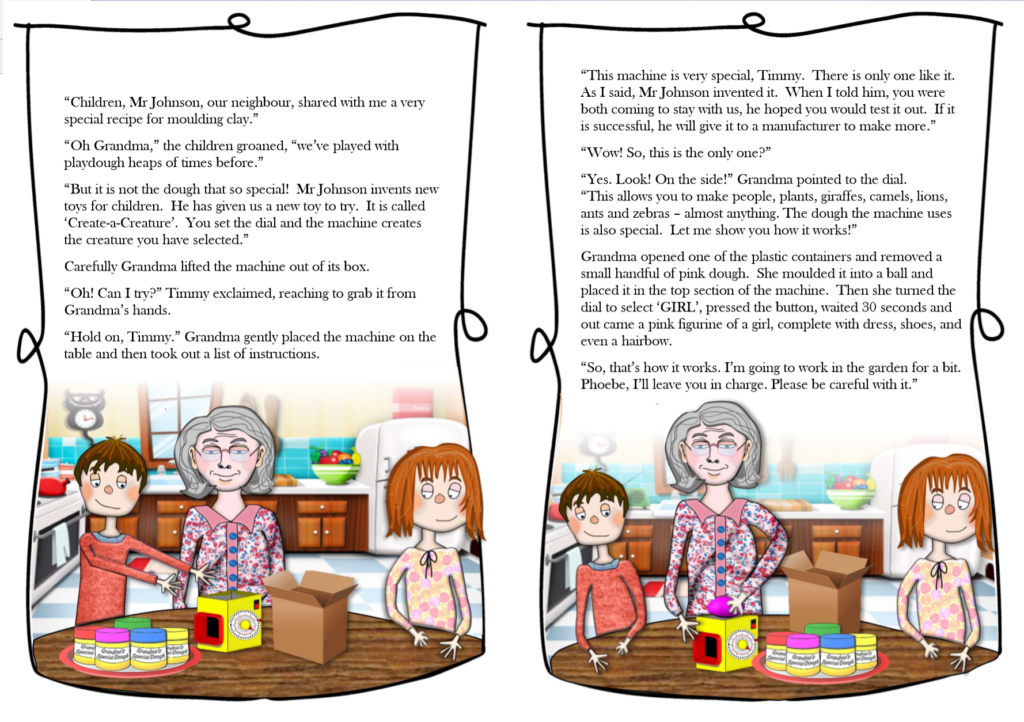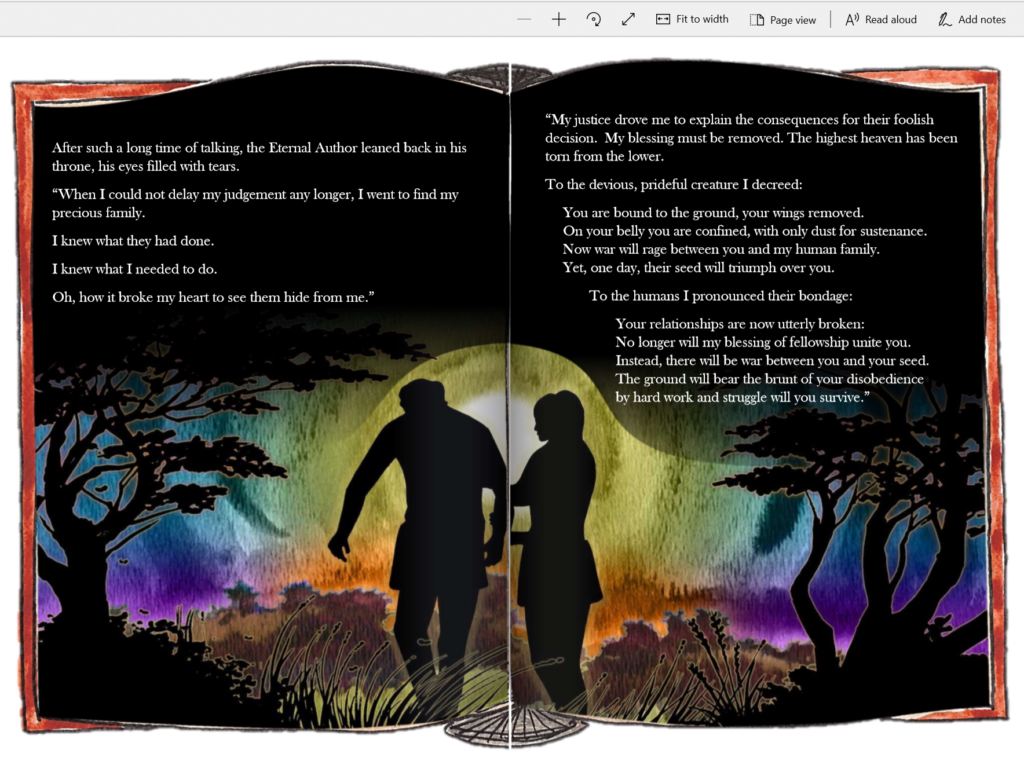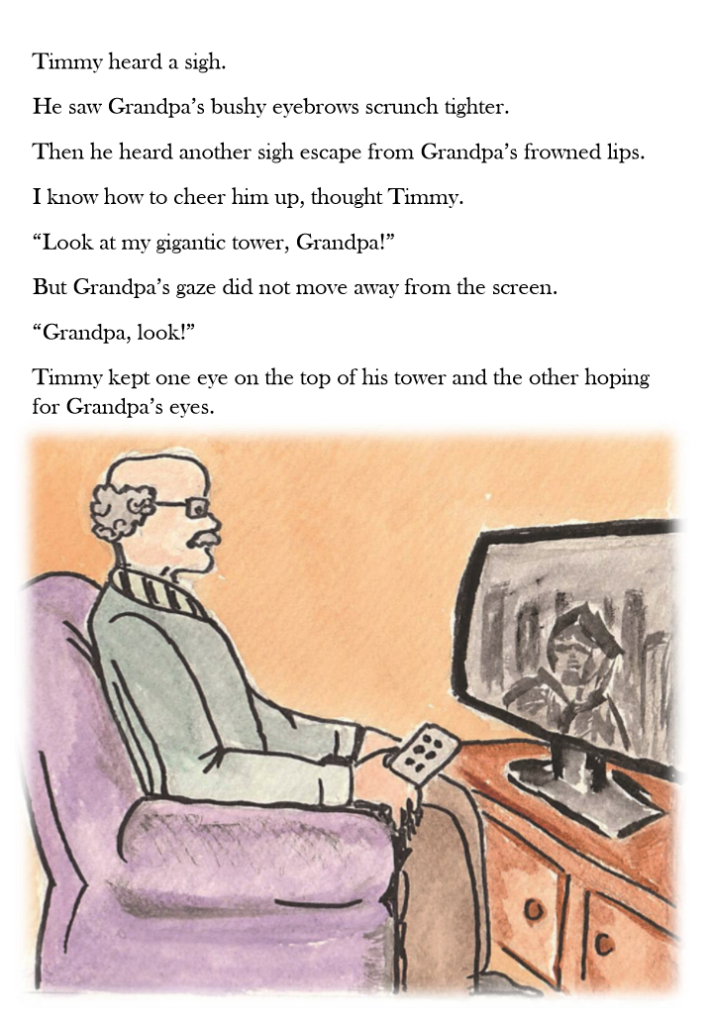I’ll start typing here …
Author: admin
The Perfect Home
Watch Book 2 of The Little Books of Blessing
The Eternal Author’s Mysterious Story
Watch The Eternal Author’s Mysterious Story:
Reflection: Post Narrative Message 2

Within days of delivering my second Narrative sermon message I received some important feedback. Some of the members of the congregation felt like they were back in school, and that my messages – because they included extracts of children’s stories – were not speaking to them. They felt I was too much in ‘teacher’ mode.
While my immediate response was one of disappointment, I could easily discern why such a feeling was pervading many of my congregants. By weaving the children’s stories through the sermons, the illustrations were not communicating the message that needed to be communicated.
So, I went back to the drawing board and thought about how to structure my narrative message so it was closer to what my mature congregation were used to.
I still wanted to use a narrative preaching approach, so I reconsidered Eugene Lowry’s structure, referred to in an earlier post, and went back to the drawing board.
The lectionary readings for this particular week were The Transfiguration of Jesus. Interestingly, the OT reading was Moses journey up the mountain to be given the law.
It was not different to structure the message so that it taught and illustrated how Jesus’ Transfiguration fit within the overarching story of the Bible.
The feedback after delivering this message was profoundly positive. Although much of their positivity towards the message was because it’s format was more familiar to them, I believe because it still had a narrative structure, with a plot and climax, it was still a joy to prepared.
Accordingly, while criticism and feedback is hard to receive at first, I believe it is essential if one is to improve on preaching God’s good news story in a powerful and effective manner.
Reflection: Post Message and Book 1

“I’d like to tell
you a story …”
On 9 February, at three services, ranging quite significantly in formality, I delivered my first narrative message: God’s Mysterious Plan. I chose the lectionary reading from 1 Corinthians 2 focusing on verse 7:
The wisdom we speak of is the mystery of God – his plan that was previously hidden, even though he made it for our ultimate glory before the world began.
1 Corinthians 2:7
The message delivery went quite well. I felt relaxed and the congregation were warmly receptive. I am sure they were surprised as hearing a narrative-shaped message was certainly new and unusual to them.
Although I did not get to sit with the 8 am congregation as they ate morning tea (and discussed the service – and the differences they perceived – I think it is important for me to reflect on some of the differences, I’m aware of, from what they are used to:
- I used more slides – about 9. These slides were mainly either a picture or a quote from the story, “The Eternal Author’s Mysterious Story”. The slides also recapped the main points.
- It was unusual for the congregation to hear a children’s story that had been woven through the message.
- Narrative preaching does not have the same feel as an exegetical sermon – I feel it may be hard to perceive that there is biblical teaching occurring, even though teaching is woven throughout the whole message.
- Starting with the dilemma or conflict, as recommended by Eugene Lowry, was good. It immediately engaged their attention. As Lowry suggests, they were trying to work out how I was going to get to the conclusion.
Of course, when I announced that the story told during the message was actually a printed children’s book that they could take with them – that got their attention. I feel that they loved the book. I did receive feedback from some parishioners about the books. Things were said like,
“I read your book. It is great. My kids I teach would really love them. Can I read it to them to my Scripture class at school?”
From a Scripture teacher
“I really loved your book. I’m going to leave it at home for my wife to read.”
A parishioner
So, overall positive feedback was received regarding the first book. I proceeded to place the books in the Op shop, in the church foyer, on the tables during Coffee Shop and also gave some to the Emergency Relief team to be placed, discerningly, in the grocery bags offered.
When I discussed the ‘story-style’ of messages and evangelism, I did discern a moment of concern. It related to a connotation that I had not originally identified.
When someone says “I love telling stories” or you comment about another person “they are a good storyteller” or “they tell stories” – all these phrases have the connotation that the person tells lies, or they make up stories for an ulterior motive. I had not recalled that ‘alternative’ meaning to the use of ‘story’.
That said, when I was looking for other words to use, other than the word ‘story’, I considered a ‘tale’ – but immediately dismissed it because ‘telling tales’ is all about lying.
So, I am currently working on how to navigate that connotation – especially when stories are told during a message. I now say upfront, “my stories are always based on a true story!”
I am so looking forward to hearing and seeing the fruit that comes from these stories. After praying over the books for three weeks, I believe the anointing of the Spirit of God is on them to carry the good news of Jesus into hearts and homes of the community at Southlakes.
The Polluted Kingdom

You will probably immediately notice that the cover of this new children’s book is vastly different from the previous ones, being “The Eternal Author’s Mysterious Story” and “The Perfect Home“.
Having both my sons on holidays, they were constantly commenting on the work I was doing on my laptop (while they worked on theirs). My eldest, Kenyon, said my books (particularly the covers) were looking too ‘Sunday Schoolish’. He said, they needed a different look – more like a normal children’s book.
So, getting rather frustrated with my inability to draw/paint people in watercolours, I went online and looked at some children’s books. I noticed that many used very easy to create illustrations – which I already had the skills to do. The result is that “The Disastrous Decision” has a very different look – with new illustrations, created by me.
However, the theme of the story is still inline with Vaughan Roberts, God’s Big Picture – unit 2 The Perished Kingdom. For some reason, I think that the word ‘polluted’ is more understandable to us Australians. The concept and subject of pollution is constantly in our newspapers, and the theological understanding that our world has been ‘contaminated by the harmful and poisonous virus of sin’ makes polluted an appropriate word choice.
The opening story was inspired by another story I had heard earlier. It opens with two children disobeying the instructions given to them. A disastrous decision means they must learn to live with the consequences.

Timmy and Phoebe play
with Create-a-Creature, but
make a disastrous decision.
The inside story, tells the story of the fall, from the Eternal King’s perspective. Although it is a relatively easy story to transliterate, I was desiring to bring out the main points which Vaughan highlights:

The Eternal King retells
a page from his story of his
human family, stained with
tears.
The story needed to include the serpent, introducing a new character. Instead of retelling the story word-for-word, I focused on the serpent’s temptation revolving around freedom – deceiving the humans into wanting to determining good from evil themselves, without the King.

The glistening creature with a fully grown
seed of pride.

With the seed of pride
lodged in their hearts, the
first humans were cast out
into a polluted world.
Then I ended the story with the restitution. Timmy and Phoebe realise that an important element of life is living with the consequences of our disastrous decisions, to learn how to make wise decisions in the future.

Learning from the consequences,
help us how to make wise decisions.
Download The Disastrous Decision now from my product page.
The Perfect Home

After consultation with my 18 year old son, who is quite talented in the area of design and graphics – we agreed on the shorter name for this Little Book of Blessing and he totally revamped the cover.
So, here is the finished cover which is about to go to the printers soon.
Book 2 of The Little Books of Blessing retells the creation story, from the perspective of the Eternal King creating a new home for his family.
The opening scenario starts with Timmy having just seen the latest superman movie. Although every superhero known to Timmy has a well-defined origin story – Timmy asks Grandpa the important question “What is the beginning of the human story?”
Download your copy of “The Perfect Home” from here now.
The Pattern of the Kingdom

We have started the series, introducing how important it is for Christians to know and understand God’s Big story.
The first unit in Vaughan Robert’s God’s Big Picture is “The Pattern of the Kingdom” which summaries the creation story in Genesis 1 and the origin of humanity in Genesis 2.
As I listened to Robert’s summary video, I could see the main points which are to be emphasised and taught in this unit.
- God is the Eternal King who created a pattern for His Kingdom.
- The Pattern of His Kingdom is broken into three parts:
a. We are God’s People
b. We are living in God’s Place
c. We have been given a Purpose and a Promise to live under God’s rule and blessing
So, starting with this structure, I designed a message which emphasised that humanity’s origin story is important because it sets the pattern for our existence, giving us:
- We are God’s People in God’s Place
- We have been given a Purpose
- We have been given a Promise
I also wanted to emphasis the importance of the Sabbath motif as the literary and theological promise of God’s establishment of his awaited Kingdom.
It did not take long to rewrite the creation story, from the perspective of God telling his story to the angels. A plethora of free illustrations were available.

The Eternal King telling the story of the very beginning.
The angels sat enthralled as God’s masterpiece unfolds.
However, determining the most appropriate title was not so easy. Some of my early ideas were:
- The Eternal King’s Magnificent Garden City
- The Eternal King’s Majestic Garden
- The Eternal King’s Original Design
- Humanity’s Original Majestic Home
- The Eternal King Creates A Perfect Home
With every story I wanted to emphasis what the felt concern or dilemma was, which the Gospel story answered.
As I reflected, I wanted to emphasise the importance of knowing one’s origin story. I read online that whenever the plot of a superhero movie is designed, the origin story is the most critical aspect. Here are some of the quotes:
“Origin stories are foundational because they address questions deeply meaningful to the society that shares them – revealing their central worldview and the framework for the self-identity of the culture and individual in a universal context.
They reveal who we are in the context of the world, and reveal and real priorities, prejudices and define the regard humans are to have for humans and nature.”
“Origin stories are like maps that help us place ourselves, and our families navigate our world and provide us with intellectual and ethical anchors.”
“Origin stories cause us to look into the future and ask how the story will continue? What do we need to do now to prepare for this future?”
Each of these quotes, convinced me of how important it is for us to know, and be confident of, God’s version of humanity’s origin.
However, this still left me to determine the introductory story – the story which raised the felt concern or dilemma.
In the next blog, I articulate the questions I used to help me determine how to develop the plot of the story which introduces: The Eternal King’s Original Garden Design. Read more>>
The Eternal Author’s Mysterious Story – Part 2

And so the Good News inspired Eternal Author’s Mysterious Story started to take shape.
4. Next, Lowry explains, it is time to move to “Yeah! Anticipating the Consequences” – What are the consequences of knowing that the Eternal Author has a mysterious plan for the world – and that mysterious plan has been revealed to his beloved children? What reassurance does that bring?
When I started to ask these questions a little song entered into my mind, a song I have sung to myself whenever I get worried about the future …
"Because he lives, I can face tomorrow. Because he lives, all fear is gone,
Because I know he holds the future,
Life is worth the living just because he lives"
Chorus from "God Sent His Son, they call him Jesus"
by Gloria and William J Gather
So, the text of the story was crafted around this song,

I know the one who holds the future …
Grandpa is reassured of The Eternal Author’s promise …
5. Finally, I needed my application. What was the congregation to do to gain this reassurance that God holds the future in his hands? How do we navigate these troubling and chaotic times, with the reassurance that God is guiding our future towards a glorious end?
And that was how the first message – the first Little Book of Blessing came to be.
Read more about “The Eternal Author’s Mysterious Story” here.
The Eternal Author’s Mysterious Story – Part 1

So … I’m running along … how do I introduce God’s eternal Love Story, with the set readings from the Anglican liturgical calendar? The first week I am scheduled to preach the New Testament passage was Paul’s first letter to the Corinthians, Chapter 2 verses 1 – 16 which starts,
“When I first came to you, dear brothers and sisters, I did not use lofty words and impressive wisdom to tell you God’s secret plan … ”
Yes … it made me giggle with praise when I read it too …
My first message to my new congregations needed to be – if I followed Paul’s advice – plain and simple (v3). And what better way to teach on the importance of learning God’s overarching Bible story – is through a simple children’s story.
So, I focused on just one verse,
“The wisdom we speak of is the mystery of God – his plan that was previously hidden, even though he made it for our ultimate glory before the world began.“
Then I asked myself some questions:
- Why do we need to know God’s plan?
- Why did God keep his plan a mystery until now?
- What is God’s mysterious plan?
- What difference does it make that God has a plan for this world?
- How does knowing that God has a mysterious plan impact our lives. Or, what difference does this truth make to our every day lives?
From the answers to these questions … and the introductory overview video of God’s Big Picture series, I had landed upon the next two stages of my message structure.
- First, Eugene Lowry, in his book The Homiletical Plot, advises that every message must start with “upsetting the equilibrium – the Oops!” In other words, in narrative preaching, you start with a felt problem or conflict.
It was fairly easy for me to determine what the felt need was – it was the answer to the last question: because everyone is worried about the world and its future … and often it feels like no one is in control.
So, now I had my opening – the first part of my children’s story – the dilemma, the question, the need for God’s good news truth.
Someone is going to be worried about the world – and when do we worry more about the world than while watching the news …

Opening page |
Grandpa is watching the news
Little Timmy can see that Grandpa worried …
2. Second, Lowry suggests we, “analyse the discrepancy – the Why?” Why do people become worried about the world? Why is Grandpa growing more and more worried about the state of the world, and his place in it? Why has the world’s story become so loud and so large? The story needed to add reality to Grandpa’s worries.
3. Only then, Lowry advises, do we move to “Disclosing the clue to the Resolution – Aha!” In my story, the clue is Grandma’s recent decision to read “The Eternal Love Story” to Timmy,

The Eternal Love Story
Grandma reads Timmy
is Introduced
The Eternal Author’s
Mysterious Story
4. Finally, Lowry explains, we introduce “Whee! Experiencing the Gospel” Inspired by the literary craftsman, Max Lucado, I imagined a scene in heaven when God, The Eternal Author, was explaining His Mysterious Plan as a story to the angelic community … So the story opened …

To see how the story ends … and how the climax of the message ended … read more …
